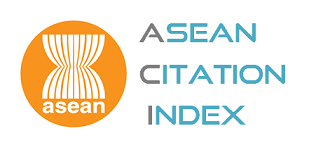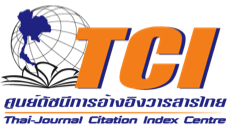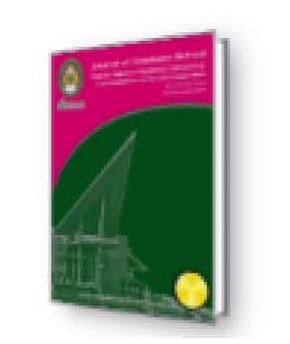การพัฒนารูปแบบการให้เงินกู้ยืมเพื่อการศึกษาของภาครัฐ ในระดับอุดมศึกษาของประเทศไทย
Abstract
การพัฒนารูปแบบการให้เงินกู้ยืมเพื่อการศึกษาของภาครัฐในระดับอุดมศึกษาของประเทศไทย
DEVELOPMENT OF EDUCTION LOAN MODEL IN THE HIGHER EDUCATION OF THAILAND
บทคัดย่อ
การวิจัยครั้งนี้มีวัตถุประสงค์เพื่อศึกษารูปแบบการให้เงินกู้ยืมเพื่อการศึกษาในระดับอุดมศึกษาของประเทศไทย ประเทศอังกฤษ และประเทศออสเตรเลีย เพื่อศึกษาข้อเด่น ข้อด้อย ของการให้เงินกู้ยืมเพื่อการศึกษาในระดับอุดมศึกษาของแต่ละประเทศเพื่อเสนอแนะรูปแบบการให้เงินกู้ยืมเพื่อการศึกษาที่เหมาะสมของประเทศไทย โดยแหล่งข้อมูลและเครื่องมือในการวิจัย ได้แก่ เอกสาร หลักฐานต่างๆ ที่เกี่ยวข้องกับการให้เงินกู้ยืมเพื่อการศึกษา และการสัมภาษณ์เจาะลึกผู้บริหารที่เกี่ยวข้องในระดับนโยบาย รวมถึงการสอบถามความคิดเห็นของผู้กู้ยืมเงินกองทุนฯ ของประเทศไทย ทั้งผู้กู้ที่อยู่ระหว่างศึกษาและผู้กู้ที่จบการศึกษาแล้วจากมหาวิทยาลัย 2 แห่ง คือ มหาวิทยาลัยมหาสารคาม และมหาวิทยาลัยราชภัฏสกลนคร เพื่อสนับสนุนผลการศึกษาโดยเครื่องมือที่ใช้คือแบบสอบถามความคิดเห็น วิเคราะห์ข้อมูลด้วยสถิติขั้นพื้นฐาน ได้แก่ ความถี่ ร้อยละ และค่าเฉลี่ย
ผลการวิจัยพบว่า
1. การให้เงินกู้ยืมเพื่อการศึกษาของประเทศไทยมี 2 รูปแบบ คือ (1) กองทุนเงินให้เงินกู้ยืมการศึกษา (กยศ.) ซึ่งเป็นการให้เงินกู้ยืมแบบที่กำหนดให้ผู้กู้ชำระหนี้เงินกู้ในอัตราและระยะเวลาที่กำหนดที่เรียกว่า Mortgage Style Loan และ (2) กองทุนเงินกู้ยืมเพื่อการศึกษาที่ผูกกับรายได้ในอนาคต (กรอ.) ซึ่งเป็นการให้เงินกู้ยืมที่ผู้กู้ชำระหนี้เมื่อมีรายได้ถึงเกณฑ์ที่กำหนด และชำระหนี้ผันแปรตามรายได้ ซึ่งเป็นลักษณะการให้กู้ที่เรียกว่า Income Contingent Loan (ICL) ให้กู้ทั้งค่าเล่าเรียนและค่าครองชีพ มีข้อเด่นคือเป็นกองทุนที่มีกฎหมายและระเบียบจัดตั้งรองรับที่ชัดเจน หลักเกณฑ์การให้กู้มีความหลากหลาย ยืดหยุ่นและผ่อนปรน เป็นเครื่องมือของภาครัฐในการเพิ่มโอกาสในการศึกษาและการแข่งขัน กรณีของกรอ. ช่วยลดภาระหนี้แก่ผู้ที่มีรายได้ไม่ถึงเกณฑ์ และมีข้อด้อยคือ เป็นช่องทางให้เกิดการปรับเปลี่ยนนโยบายของนักการเมืองในแต่ละสมัย ไม่มีการจัดเก็บหนี้ผ่านหน่วยงานด้านสรรพากรมีผู้เกี่ยวข้องกับการดำเนินงานค่อนข้างมากและซ้ำซ้อน เงื่อนไขที่ผ่อนปรนมากเกินไปทำให้เกิดปัญหาในการชำระหนี้และการติดตามหนี้ เป็นต้น
2. การให้เงินกู้ยืมเพื่อการศึกษาของประเทศอังกฤษ ปัจจุบันมีการให้กู้ 2 ประเภทหลัก คือ ประเภท Mortgage-style System หรือ Fixed Term Loan สำหรับผู้กู้ในระยะแรก และประเภท Income-contingent Loan (ICL) ประกอบด้วยประเภท ICL “Plan 1” และ ICL “Plan 2” ให้กู้เพื่อเป็นค่าเล่าเรียนและค่าครองชีพ มีข้อเด่นคือ ปัจจุบันเป็นรูปแบบที่ผูกพันกับรายได้ในอนาคต ซึ่งเปิดโอกาสให้ผู้กู้เข้าถึงแหล่งเงินกู้ได้มากขึ้นมีหน่วยงานกำกับดูแลชัดเจน มีระบบการจัดเก็บหนี้โดยผ่านสำนักงานสรรพากรและศุลกากร การชำระหนี้ตามเกณฑ์รายได้ทำให้คนที่มีรายได้ต่ำไม่ต้องแบกรับภาระการชำระหนี้เป็นต้น โดยมีข้อด้อย คือ ให้กู้เฉพาะระดับปริญญาตรี การกำหนดอัตราการชำระคืนตามเกณฑ์รายได้เฉพาะส่วนที่เกินกว่าเกณฑ์ที่กำหนดทำให้ได้จำนวนเงินที่ผู้กู้ชำระคืนแต่ละงวดอาจไม่มากพอ มุ่งเน้นด้านเศรษฐกิจเป็นหลัก การกำหนดอัตราดอกเบี้ยสำหรับผู้ที่มีรายได้สูงไว้สูงจนอาจทำให้เกิดการหลีกเลี่ยงการแจ้งรายได้ที่แท้จริง ไม่มีระบบการติดตามรายได้สำหรับกลุ่มที่ไม่อยู่ในระบบการจ้างงาน
3. การให้เงินกู้ยืมเพื่อการศึกษาของประเทศออสเตรเลียปัจจุบันเป็นรูปแบบการให้กู้แบบ Income - contingent Loan (ICL) โดยแบ่งเงินกู้ออกเป็น 5 ประเภท คือ 1) HECS-HELP Loan Scheme 2) The FEE-HELP Loan Scheme 3) SA-HELP Loan Scheme 4) OS-HELP Loan Scheme และ 5) VET FEE-HELP Loan Scheme ให้กู้ทั้งค่าเล่าเรียนและค่าธรรมเนียมในการบริการนักศึกษาหรือค่าธรรมเนียมในการอำนวยความสะดวกต่างๆ รวมถึงค่าใช้จ่ายในการเรียนบางรายวิชาในต่างประเทศโดยมีข้อเด่น คือ มีรูปแบบการให้กู้ยืมหลากหลายแบบที่ผู้กู้สามารถเลือกกู้ได้ตามความเหมาะสม มีรูปแบบการสนับสนุนเงินกู้ยืมกับสถานศึกษาเอกชนรวมถึงการให้กู้กับกลุ่มอาชีวศึกษา กำหนดการชำระหนี้คืนตามระดับรายได้ทำให้ผู้กู้ที่มีรายได้น้อยไม่ต้องจ่ายเงินกู้ เป็นต้น มีข้อด้อยคือ มีความเสี่ยงในการชำระหนี้ของผู้กู้ที่อาจมีรายได้ต่ำกว่าในอนาคต และอาจเป็นภาระแก่ภาครัฐระดับการชำระหนี้ยังขึ้นกับภาวะเศรษฐกิจเป็นหลัก เนื่องจากการกำหนดอัตราดอกเบี้ยอิงตามดัชนีราคาสินค้าขายปลีก
Abstract
The purpose of this research is to study educational loan models for higher education in Thailand, the United Kingdom and Australia, as well as their strengths and weaknesses, and to propose educational loan models that are suitable for Thailand. Research information and tools to support the research included documents related to educational loans, in-depth interviews with administrators involved at the policy level, and interviews with borrowers of the Student Loan Fund (SLF) in Thailand. These included borrowers who are studying and those who are graduated borrowers from two universities: Mahasarakham University and Sakon Nakhon Rajabhat University. The tool used for the research was a questionnaire and information was analyzed based on basic statistics, namely frequency, percentages and mean. The
findings of the research were as follows
1. There are two types of educational loans in Thailand – (1) the Student Loan Fund (SLF) specifying that borrowers must settle loans at a specified rate and timeframe called a “Mortgage Style Loan” and (2) the Thailand Income Contingent Allowance and Loan (TICAL), which specifies that borrowers must repay loans when they have an income as specified by the policy and settle loans according to their income, which referred to as an “Income Contingent Loan” (ICL). The loans include both tuition fees and living costs. Their strengths are that those funds are supported by laws and regulations, and the loan criteria is diverse and flexible. They are a tool of the public sector for increasing opportunities for education and competition. In the case of the TICAL, it can lessen the burden of debt for low income earners. Their weakness is there is a channel for changing the policy of politicians in each period. Additionally, no debts were collected by the Department of Revenue and a large number of people involved and the process were duplicated. Too many relaxed conditions cause repayment and collection problems etc.
2. There are two types of loans in the United Kingdom: the mortgage-style system or a fixed term loan for borrowers and an income-contingent loan (ICL), consisting of ICL “Plan 1” and ICL “Plan 2” for tuition fees and living costs. Their strengths are that they are income-contingent loans. This gives borrowers more accessible to loan sources. In addition, there are monitoring agencies and debt collection systems by the Office of Revenue and the Office of Customs. Moreover, debt repayment in accordance with their income makes low income earners not bear too much of the burden for repayment etc. Their weaknesses are that the loans are provided to only students at the undergraduate level. It was also specified that loans will be repaid according to income and only the amount exceeding the criteria will be paid. The amount that borrowers settle towards their loans in each installment is not sufficient. The loan grant focuses mainly on the economy, with high interest rates fixed for high income earners which may lead to false disclosure of information about their income. Finally, there is no income monitoring system for borrowers who are not in the employment system.
3. Educational loans in Australia are currently income-contingent loan (ICL) and divided into five types: 1) the HECS-HELP Loan Scheme, 2) the FEE-HELP Loan Scheme, 3) the SA-HELP Loan Scheme, 4) the OS-HELP Loan Scheme and 5) the VET FEE-HELP Loan Scheme. Loans are given in terms of tuition fees and charges for student services or fees for facilitation, including expenses for some overseas courses. Their strengths are the diversity of loans which borrowers can select to suit their demand. They also provide loans for private educational institutions and vocational students. Furthermore, loan repayment is in accordance with income level, and as a result low income borrowers do not have to repay them etc. Their weaknesses are that there are risks in the loan settlement of borrowers with a low income in the future. This may cause a burden to the public sector. Finally, loan settlement depends mainly on economic conditions because the interest rates are based on the index of retail prices.
Downloads
How to Cite
Issue
Section
License
บทความทุกบทความที่ตีพิมพ์ในวารสารบัณฑิตศึกษา มหาวิทยาลัยราชภัฏสกลนคร ถือว่าเป็นลิขสิทธิ์ของบัณฑิตวิทยาลัย มหาวิทยาลัยราชภัฏสกลนคร









